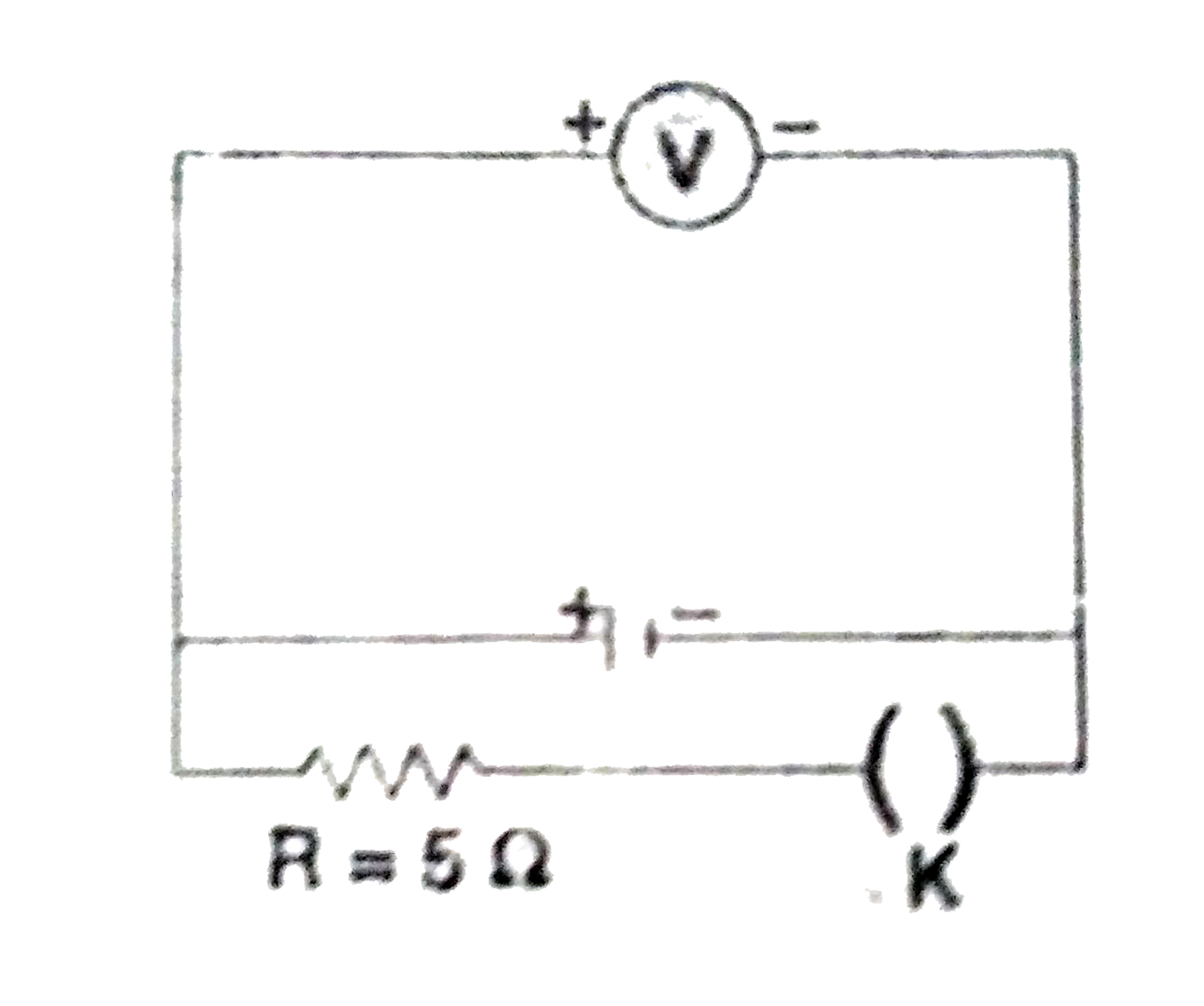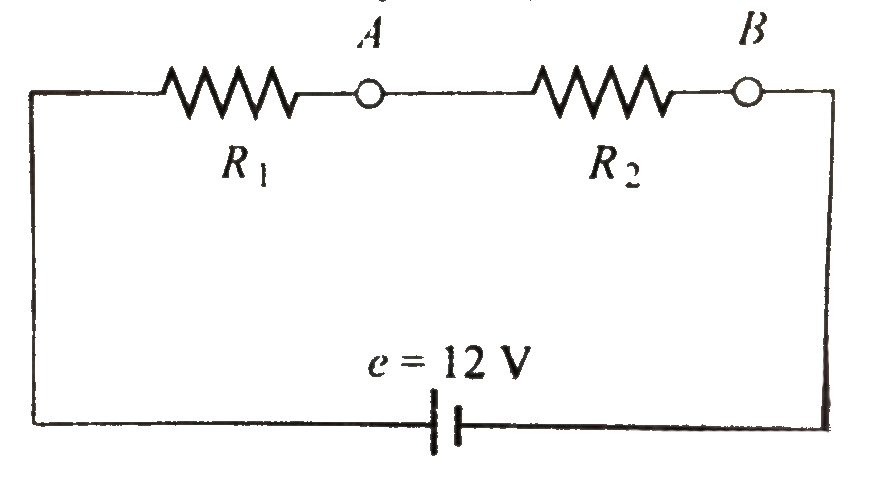The reading on a high resistance voltmeter when a cell is connected across it is 3 V. When the terminals of the cell are also connected to a resistance of 4 Ω, then the voltmeter reading drops to 1.2 V. Find the internal resistance of the cell.
To find the internal resistance of the cell, we can follow these steps:
Step 1: Understand the given information
- The EMF (Electromotive Force) of the cell is given as E=3V when connected to a high resistance voltmeter.
- When a 4Ω resistor is connected across the cell, the voltmeter reading drops to V=1.2V.
Step 2: Use the formula for internal resistance
The relationship between the EMF, the terminal voltage, and the internal resistance can be expressed using the formula:
V=E−I⋅r
Where:
- V is the terminal voltage (1.2 V in this case),
- E is the EMF of the cell (3 V),
- I is the current flowing through the circuit,
- r is the internal resistance of the cell.
Step 3: Calculate the current I
The current I can be calculated using Ohm's law. The total resistance in the circuit when the resistor is connected is:
Rtotal=R+r=4Ω+r
Using Ohm's law, we can express the current I:
I=VR=1.24=0.3A
Step 4: Substitute I into the internal resistance formula
Now, we can substitute I into the internal resistance formula:
1.2=3−0.3⋅r
Step 5: Rearrange the equation to solve for r
Rearranging the equation gives:
0.3⋅r=3−1.2
0.3⋅r=1.8
r=1.80.3=6Ω
Final Answer
The internal resistance of the cell is r=6Ω.
---
- The EMF (Electromotive Force) of the cell is given as E=3V when connected to a high resistance voltmeter.
- When a 4Ω resistor is connected across the cell, the voltmeter reading drops to V=1.2V.
The relationship between the EMF, the terminal voltage, and the internal resistance can be expressed using the formula:
V=E−I⋅r
Where:
- V is the terminal voltage (1.2 V in this case),
- E is the EMF of the cell (3 V),
- I is the current flowing through the circuit,
- r is the internal resistance of the cell.
The current I can be calculated using Ohm's law. The total resistance in the circuit when the resistor is connected is:
Rtotal=R+r=4Ω+r
Using Ohm's law, we can express the current I:
I=VR=1.24=0.3A
Now, we can substitute I into the internal resistance formula:
1.2=3−0.3⋅r
Rearranging the equation gives:
0.3⋅r=3−1.2
0.3⋅r=1.8
r=1.80.3=6Ω
The internal resistance of the cell is r=6Ω.
Topper's Solved these Questions
- CURRENT ELECTRICITYBOOK - DC PANDEY ENGLISHCHAPTER - CURRENT ELECTRICITYEXERCISE - Check point
70 Videos
- CURRENT ELECTRICITYBOOK - DC PANDEY ENGLISHCHAPTER - CURRENT ELECTRICITYEXERCISE - Taking it together
142 Videos
- CURRENT ELECTRICITYBOOK - DC PANDEY ENGLISHCHAPTER - CURRENT ELECTRICITYEXERCISE - Level 2 Subjective
13 Videos
- COMMUNICATION SYSTEMBOOK - DC PANDEY ENGLISHCHAPTER - COMMUNICATION SYSTEMEXERCISE - Subjective
11 Videos
- ELECTROMAGNETIC INDUCTIONBOOK - DC PANDEY ENGLISHCHAPTER - ELECTROMAGNETIC INDUCTIONEXERCISE - Medical entrances gallery
25 Videos
Similar Questions
Write any two factors on which internal resistance of a cell depends . The reading on a high resistance voltmeter , when a cell is connected across it , is 2.0 V . When the terminals of the cell are also connected to a resistance of 3Ω as shown in the circuit , the voltmeter reading drops to 1.5 V . Find the internal resistance of the cell.
View SolutionWrite any two factors on which internal resistance of a cell depends .The reading on a high resistance voltmer,where a cell is connected across it , is 2.2 V. When the terminals of the cell are also connected to a resistance of 5 Ω as shown in the circuit , the voltmeter reading drops to 1.8 V .Find the interval resistance of the cell.

View SolutionThe emf of a daniel cell is 1.08V. When the terminals of the cell are connected to resistance of 3Ω, the potential difference across the terminals is found to be 0.6 V. Then , the internal resistance of the cell is
View SolutionA cell has an emf 1.5V. When connected across an external resistance of 2Ω, the terminal potential difference falls to 1.0V. The internal resistance of the cell is:
View SolutionIn a potentiometer experiment, the galvanometer shows no deflection when a cell is connected across 60cm of the potentiometer wire. If the cell is shunted by a resistance of 6Ω, the balance is obtained across 50cm of the wire. The internal resistance of the cell is
View SolutionIn a potentiometer experiment it is found that no current passes through the galvanometer when the terminals of the cell are connected across 0.52m of the potentiometer wire. If the cell is shunted by a resistance of 5Ω balance is obtained when the cell connected across0.4m of the wire. Find the internal resistance of the cell.
View SolutionIn a potentiometer experiment it is found that no current passes through the galvanometer when the terminals of the cell are connected across 0.52m of the potentiometer wire. If the cell is shunted by a resistance of 5Ω balance is obtained when the cell connected across0.4m of the wire. Find the internal resistance of the cell.
View SolutionA high resistance voltmeter measures the potential difference across a battery to be 9-0 V. On connecting a 24 2 resistor across the terminals of the battery, the voltmeter reads 7.2 V. Calculate the internal resistance of the battery.
View SolutionThe cell has an emf of 2V and the internal resistance of this cell is 0.1Ω, it is connected to resistance of 3.9Ω, the voltage across the cell will be
View SolutionWhen an ammeter of negligible internal resistance is inserted in series with circuit, it reads 1A. When a voltmeter of very large resistance is connected across R1, it reads 3V. But when the points A and B are short-circuited by a conducting wire, then the voltmetre measures 10.5V across the battery. The internal resistance of the battery is equal to

View Solution
